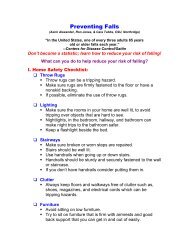Why Shoes Make “Normal” Gait Impossible - RonJones.Org
Why Shoes Make “Normal” Gait Impossible - RonJones.Org
Why Shoes Make “Normal” Gait Impossible - RonJones.Org
You also want an ePaper? Increase the reach of your titles
YUMPU automatically turns print PDFs into web optimized ePapers that Google loves.
<strong>“Normal”</strong> <strong>Gait</strong>...<br />
strike moves to the lateral-rear corner of the heel toplift.<br />
(Fig. 8). This is not natural. The heel of the shoeless<br />
foot receives its initial heel strike not at the lateral-rear<br />
corner but in the center at the site of the plantar calcaneal<br />
tuberosity. (Fig. 9) The natural plantar path of<br />
the step sequence—heel to lateral border to ball to hallux<br />
and push-off (Fig. 10)—is forced to shift, further affecting<br />
natural gait.<br />
Let’s add one further influence of shoe heels, low to<br />
high. The shoe’s elevated heel shortens the Achilles<br />
tendon and there is also an accompanying shortening<br />
of the calf muscles (Fig. 11). Both the tendon and the<br />
muscles are, of course, vital to step propulsion and gait<br />
stamina—which may help to explain the performance<br />
dominance of marathon runners from nations where<br />
the barefoot state is common from infancy to adulthood.<br />
The heeled shoe “steals” much of this propulsive<br />
power from the tendon and leg muscles. This not only<br />
places more stress on them to achieve needed propulsion,<br />
but power must be borrowed from elsewhere—<br />
knees, thigh muscles, hips, and trunk. A small army of<br />
anatomical reinforcements must come to the rescue of<br />
the handicapped tendon and calf muscles.<br />
Thus a shoe heel of any height sets in motion a series<br />
of gait-negative consequences, making natural<br />
gait—meaning the barefoot form—impossible. But this<br />
is only the beginning.<br />
Toe Spring<br />
If you rest a shoe, new or old, on a table and view it<br />
in profile from the side, it reveals an up-tilt of the toe<br />
tip varying from five-eighths to one inch or more. More<br />
on worn shoes. This is known as “toe spring” and is<br />
built into the last (Fig. 12).<br />
On the bare, natural foot the digits rest flat, their<br />
tips grasping the ground as an assist in step propulsion.<br />
(Fig.13) Inside the shoe, the digits are lifted slantwise<br />
off the ground, unable to fulfill their natural groundgrasping<br />
function.<br />
So why is toe spring built into the last and shoe? To<br />
compensate for lack or absence of shoe flexibility at the<br />
ball. The toe spring creates a rocker effect on the shoe<br />
sole so that the shoe, instead of full flexing as it should,<br />
forces the foot to “roll” forward like the curved bottom<br />
of a rocking chair. The thicker the sole, such as on<br />
sneakers or work boots, or the stiffer the sole (such as<br />
on men’s Goodyear welt wingtip brogues), the greater<br />
the toe spring needed because of lack of shoe flexibility.<br />
With toe spring, the toes of the foot are constantly<br />
angled upward five to twenty degrees, depending upon<br />
the amount of shoe toe spring. Functionally, they are<br />
“forced out of business,” denied much or all of their<br />
natural ground-grasping action and exercise so essential<br />
to exercising of the whole foot because 18 of the foot’s<br />
19 tendons are attached to the toes.<br />
The combination of the up-tilted toes caused by the<br />
toe spring, and the down-slanted heel and foot caused<br />
by the heel wedge angle, create an angle apex at the<br />
Continued on page 54<br />
Fig. 13: Normal flat plane of digits, enabling<br />
them to fulfill natural ground-grasping action in<br />
taking a step. They are<br />
functionally immobilized<br />
by uptilted toe<br />
spring of shoe.<br />
PODIATRY MANAGEMENT • MARCH 1999 53













